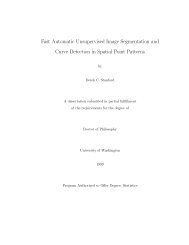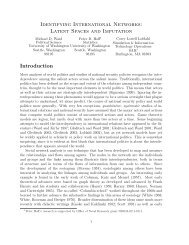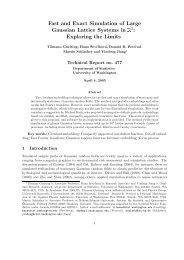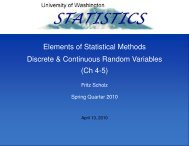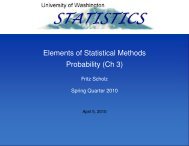Probability and Statistics in Engineering and Science, STAT/MATH ...
Probability and Statistics in Engineering and Science, STAT/MATH ...
Probability and Statistics in Engineering and Science, STAT/MATH ...
You also want an ePaper? Increase the reach of your titles
YUMPU automatically turns print PDFs into web optimized ePapers that Google loves.
Statistical Methods <strong>in</strong> Eng<strong>in</strong>eer<strong>in</strong>g <strong>and</strong> <strong>Science</strong>, <strong>STAT</strong>/<strong>MATH</strong> 390<br />
This is a fluid syllabus, so check frequently for changes <strong>in</strong> colors<br />
Instructor: Caren Marzban (The best way to reach me is email)<br />
Class Times <strong>and</strong> Room: MTWTh 9:40-10:40 THO 125.<br />
Quiz/Lab Times <strong>and</strong> Room: Tuesday 12:00-1:00 (AA) or 1:10-2:10 (AB) <strong>in</strong> CMU B027.<br />
Name (PDL office) Email Off. hours/location<br />
Caren Marzban (B318) marzban at uw.edu M. 12-1 (CMU B23 ∗ ); W. 12-1 (B318)<br />
Andrew Giff<strong>in</strong> (None) agiff<strong>in</strong> at uw.edu M. 2-3 (CMU B23 ∗ ); Th. 2-3 (B23)<br />
CMU B023 is an <strong>in</strong>formal place where you can stay <strong>and</strong> do your work, even outside of our office. Check<br />
their open times here: http://www.stat.wash<strong>in</strong>gton.edu/www/tutorcenter/<br />
Course webpage: http://www.stat.wash<strong>in</strong>gton.edu/marzban/390/<br />
Consult the webpage frequently, because th<strong>in</strong>gs change. Look for colors .<br />
Text: Applied <strong>Statistics</strong> for Eng<strong>in</strong>eers <strong>and</strong> Scientists (2nd Edition), by Devore <strong>and</strong> Farnum. Do<br />
NOT get other editions.<br />
Note different purchas<strong>in</strong>g options: www.cengagebra<strong>in</strong>.com offers the pr<strong>in</strong>ted text, rental text, digital<br />
text, <strong>and</strong> digital chapters.<br />
Buzz words/concepts: Data, histogram vs. distribution, mean vs. expected value, sample st<strong>and</strong>ard<br />
deviation vs. population st<strong>and</strong>ard deviation, conditional probability vs. unconditional probability,<br />
b<strong>in</strong>omial distribution, normal (gaussian) distribution, etc. sampl<strong>in</strong>g distribution, scatterplot,<br />
correlation, regression, estimation, prediction, <strong>in</strong>ference, confidence <strong>in</strong>terval, prediction <strong>in</strong>terval,<br />
hypothesis/significance test<strong>in</strong>g, 1-way anova, <strong>and</strong> more.<br />
Lab/Comput<strong>in</strong>g <strong>and</strong> Quizes: Some basic comput<strong>in</strong>g will be called for. You won’t need to know<br />
any <strong>in</strong> advance, but you will have to learn it dur<strong>in</strong>g the course. We will use a language called R;<br />
consult the R stuff on the course webpage. Other languages are acceptable, but R will be better<br />
because 1) You will need it to do some of the homework assignments, <strong>and</strong> 2) you will get quized on<br />
it dur<strong>in</strong>g the labs.<br />
Homework <strong>and</strong> Tests: A list of problems from the book (see ”master list”) AND their solutions<br />
are already posted on the course website. Most hw problems will be assigned from this master list,<br />
plus a few more which will be assigned with<strong>in</strong> the body of the lecture notes. Homework problems<br />
will be assigned daily (MWTh) after class, <strong>and</strong> are due every Tuesday <strong>in</strong> quiz session; only the<br />
assignments from the previous week are due: M,W,Th → T; M,W,Th → T; etc. Check the course<br />
website for the latest <strong>in</strong>formation on HWs <strong>and</strong> due dates. Beg<strong>in</strong> work<strong>in</strong>g on the assignments as soon<br />
as you receive them. Tests will <strong>in</strong>volve variations on the hw problems. On homework, tests, <strong>and</strong><br />
quizes provide detail <strong>in</strong> your solutions, not just an answer. An answer, even a correct<br />
one, will not get credit if there is no accompany<strong>in</strong>g explanation/derivation/proof.
Grad<strong>in</strong>g:<br />
Homework: 10% (after dropp<strong>in</strong>g ONE lowest grade)<br />
Pop Quizes: 15% (after dropp<strong>in</strong>g ONE lowest grade)<br />
Test 1: 24% (mostly comprehensive)<br />
Test 2: 25% (mostly comprehensive)<br />
Test 3: 26% (mostly comprehensive)<br />
The f<strong>in</strong>al grade will be based on a “curve”; I will expla<strong>in</strong> this <strong>in</strong> class, but an explanation is given on<br />
the course website, as well. Tak<strong>in</strong>g all 3 tests is an absolute requirement for pass<strong>in</strong>g. If a significant<br />
number of homeworks or quizes are miss<strong>in</strong>g, the f<strong>in</strong>al grade will be down-weighted.<br />
Tests: Although the quizes <strong>and</strong> homework are open note/book/web/everyth<strong>in</strong>g, the three tests are<br />
CLOSED EVERYTHING , except for a s<strong>in</strong>gle sheet of paper 8.5” × 5.5” (i.e., half of a st<strong>and</strong>ard<br />
sheet) both sides of which you may write anyth<strong>in</strong>g you wish. NOTE: A double-sided half-sheet is<br />
NOT the same th<strong>in</strong>g as a 1-sided whole sheet! Try to work out as many problems as you can from<br />
the above-mentioned master list of problems, because that is the best way of study<strong>in</strong>g for the<br />
tests. Read<strong>in</strong>g the book <strong>and</strong> the lecture notes will help especially on the conceptual part of the<br />
tests.<br />
General Policy: You’ll f<strong>in</strong>d me reasonably flexible, with emphasis on reasonably. I don’t want<br />
this syllabus to look like a legal contract. Just do what you are supposed to, <strong>and</strong> don’t do what<br />
you are not supposed to; <strong>and</strong> you know what those are! In general<br />
- Attendance is expected; don’t send me email questions if you don’t attend lectures. (In<br />
one lab you will analyze data from past quarters, show<strong>in</strong>g that attendance is correlated with grade.)<br />
- No makeups. In case of emergency, provide 2-week prior notice.<br />
- No late homeworks.<br />
- No cheat<strong>in</strong>g/collaboration on tests (I’m quite <strong>in</strong>flexible on this one).<br />
Po<strong>in</strong>t 1: This course is NOT your regular math course! It <strong>in</strong>volves more “words” <strong>and</strong> qualitative,<br />
nonl<strong>in</strong>ear th<strong>in</strong>k<strong>in</strong>g than a typical math course. In fact, I will show you data from previous quarters<br />
show<strong>in</strong>g that mathematical ability does not correlate well with performance <strong>in</strong> this class.<br />
Po<strong>in</strong>t 2: The material beg<strong>in</strong>s extremely simple but becomes complex very quickly. So, keep up.<br />
Po<strong>in</strong>t 3: I will follow the text book closely. You are expected to have read the material of the day<br />
before I go over it <strong>in</strong> class. As such, the purpose of my lectures is to review, <strong>and</strong> to highlight some<br />
of the more important but less obvious issues. Follow<strong>in</strong>g <strong>and</strong> underst<strong>and</strong><strong>in</strong>g the book <strong>and</strong><br />
the lectures is necessary but NOT sufficient for underst<strong>and</strong><strong>in</strong>g the material. Aga<strong>in</strong>,<br />
the best way for that is to do more problems from the list <strong>and</strong>/or book.<br />
Po<strong>in</strong>t 4: Please check out the FAQ on the course website for my answers to many of your questions,<br />
before you send me a question/suggestion.<br />
NEXT PAGE: Daily schedule for the whole quarter: It is tentative, so CHECK FREQUENTLY!<br />
St<strong>and</strong>ard end<strong>in</strong>g regard<strong>in</strong>g disabilities, etc. ...
Lecture Date Read<strong>in</strong>g (Chapters) Notes<br />
1 6/23 1.1-1.2<br />
2 6/24 1.2-1.3 Lab 1: R basics <strong>and</strong> Ch. 1<br />
3 6/25 1.3,1.4,1.6 Skip 1.5<br />
4 6/26 1.4, 1.6<br />
5 6/30 2.1, 2.3 Skip p. 84.<br />
6 7/1 2.1-2.2 Lab 2: Ch. 1-2<br />
7 7/2 3.1-3.2<br />
8 7/3 3.2-3.3<br />
9 7/7 3.3-3.4 Skip 3.6 <strong>and</strong> Ch. 4<br />
10 7/8 3.5,5.1 Lab 3: Ch. 3<br />
- 7/9 Sample test, Q/A<br />
- 7/10 TEST 1 Up to lecture 8 (<strong>in</strong>clusive). Lab 3: Ch.2-3<br />
11 7/14 5.1-5.3<br />
12 7/15 5.6 & Return<strong>in</strong>g/go<strong>in</strong>g over Test 1 Attendance IMPORTANT! Lab 4: Ch. 3<br />
13 7/16 5.3, 5.5 Skip 5.4.<br />
14 7/17 5.6, 7.2 Skip Ch.6 <strong>and</strong> 7.1.<br />
15 7/21 7.3<br />
16 7/22 7.4 Lab 5: Ch. 5,7<br />
17 7/23 7.5 Skip sec 7.6 <strong>and</strong> pages 317-319<br />
18 7/24 8.1-8.2<br />
19 7/28 8.2, 8.5<br />
20 7/29 8.1, 8.3 Lab 6: Ch. 7<br />
- 7/30 Sample test, Q/A<br />
- 7/31 TEST 2 Up to lect 18 (<strong>in</strong>clusive); emphasis on latter half.<br />
21 8/4 8.3, 8.5 Skip 8.4, subsec on p. 391, & last subsec. on p. 393.<br />
22 8/5 8.5(power) & Return<strong>in</strong>g/go<strong>in</strong>g over Test 2 Attendance IMPORTANT! Lab 7: Ch. 7-8<br />
23 8/6 9.1-9.2<br />
24 8/7 9.3 Skip 9.4. We’ll do 9.3 only <strong>in</strong> the lab.<br />
25 8/11 11.1, 11.2<br />
26 8/12 11.3 Lab 8: Ch. 8,9,11<br />
27 8/13 11.4, 11.5 Skip subsecs on p.522, 532<br />
28 8/14 Ch.11 Skip 11.6 except model selection & multicoll<strong>in</strong>earity.<br />
29 8/18 Cushion time<br />
- 8/19 Q/A & sample test Lab 9: Ch 11.<br />
- 8/20 Q/A & evaluation<br />
- 8/21 TEST 3/F<strong>in</strong>al Exam Comprehensive, emphasis on latter material.



